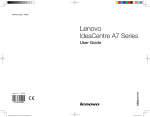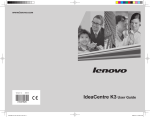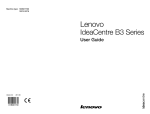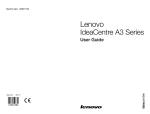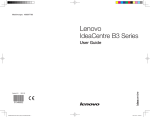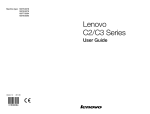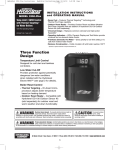Download Lenovo 10057/7712 Personal Computer User Manual
Transcript
Machine type: 10057/7712 Lenovo IdeaCentre B5 Series User Guide Version 2.0 2010.07 31044787 Important Safety Information Before using this manual, it is important that you read and understand all of the related safety information for this product. Refer to the Safety and Warranty Guide that you received with this product for the latest safety information. Reading and understanding this safety information reduces the risk of personal injury or damage to your product. Danger: Be aware of extremely hazardous or lethal situations. Attention: Be aware of possible damage to programs, devices, or data. Note: Pay attention to this important information. © Copyright Lenovo 2010. Contents Important Safety Information Chapter 1 Using the Computer Hardware............................... 1 1.1Front view.................................................................................2 1.2Left and right view of the computer..........................................3 1.3Rear view of the computer........................................................4 1.4Computer stand.......................................................................5 1.5Connecting your computer.......................................................6 1.6Important information about using the computer......................9 1.7Keyboard................................................................................11 1.8Using the Infra-red (IR) Remote Control..................................12 1.9Using the Bluetooth remote control........................................19 Chapter 2 Using the Rescue System..................................... 31 2.1OneKey Recovery...................................................................32 2.2Driver and Application Installation...........................................32 2.3System Setup.........................................................................33 2.4System Backup......................................................................34 2.5System Recovery...................................................................34 2.6Create Recovery Disc.............................................................34 Chapter 3 Using the Computer Software.............................. 35 3.1Lenovo Dynamic Brightness system.......................................36 3.2Lenovo Eye Distance System.................................................37 Chapter 4 System Maintenance and Recovery..................... 39 4.1Restoring the System.............................................................40 4.2Backup and Restore...............................................................40 Contents 1 4.3Cleaning Up the Disk..............................................................40 4.4Checking For, and Correcting Disk Errors...............................41 4.5Defragmenting the Disk(s).......................................................41 4.6Performing Daily Maintenance Tasks.......................................41 Chapter 5 Troubleshooting and Confirming Setup............... 43 5.1Troubleshooting Display Problems..........................................44 5.2Troubleshooting Audio Problems............................................45 5.3Troubleshooting Software Problems.......................................45 5.4Troubleshooting Problems with Optical Drives and Hard Disks..............................................................................46 5.5Special considerations for troubleshooting Windows..............47 5.6Wireless keyboard and mouse instructions.............................48 2 Contents Chapter Using the Computer Hardware This chapter contains the following topics: 1 2 Computer hardware introduction Information on computer connections Note: The descriptions in this chapter might vary from your computer, depending on computer models and configurations. 3 4 5 User Guide 1 1.1Front view Built-in microphone Camera Indicator lights ON/OFF button Volume down Volume up Brightness down Brightness up LCD On/Off 2 User Guide 1.2Left and right view of the computer Attention: Be sure not to block any air vents on the computer. Blocked air vents may cause thermal problems. 2 3 5 6 4 1 Optical drive USB ports (2) Power button Headphone connector Card reader Microphone connector User Guide 3 1.3Rear view of the computer 7 14 4 8 9 10 11 13 12 AV-IN connector (Selected models only) TV-Tuner connector (Selected models only) PS/2 Keyboard connector eSATA port Ethernet connector Wireless reset button USB ports (2) Power connector User Guide 1.4Computer stand 15° min. 35° max. Use the stand to position the display to your preference. It can be rotated between 15º and 35º from the vertical. The stand provides stability to the computer; it is not a removable part. Attention: 1. The computer stand must remain installed at all times to ensure maximum system stability. 2. Make sure the angle of the computer is at least 15 degrees from the vertical; otherwise the computer will be unstable and could fall over. To open the computer stand, do the following: User Guide 5 1.5Connecting your computer Use the following information to connect your computer: • Look for the small connector icons on the back of your computer. Match the connectors to the icons. Note: Your computer might not have all of the connectors that are described in this section. 1.5.1Check the voltage rating before you connect the equipment to an electrical outlet to ensure that the required voltage and frequency match the available power source. 1.5.2Connect the keyboard cable to the appropriate keyboard connector (PS2 connector or USB connector). 1.5.3Connect the mouse cable to the appropriate mouse connector (USB connector). 6 User Guide 1.5.4If you have audio devices, attach them using the following instructions: 1 2 Microphone Use this connector to attach a microphone (purchased separately) to your computer when you want to record sound or if you use speech-recognition software. Headphone Use this connector to attach headphones (purchased separately) to your computer when you want to listen to music or other sounds without disturbing anyone. 1.5.5If you have powered speakers with an adapter: (This picture is only a sketch print, it does not show the actual figure of the speaker) a. Connect the cable that runs between the speakers if necessary. On some speakers, this cable is permanently attached. b. Connect the adapter cable to the speaker if necessary. On some speakers, this cable is permanently attached. c. Connect the speakers to the Headphone port on the computer. d. Connect the adapter to the power source. User Guide 7 1.5.6If you have powered speakers without an adapter: (This picture is only a sketch print, it does not show the actual figure of the speaker) a. Connect the cable that runs between the speakers if necessary. On some speakers, this cable is permanently attached. b. Connect the cable to the speaker if necessary. On some speakers, this cable is permanently attached. c. Connect the speakers to the Headphone port on the computer. d. Connect the plug to the power source. Note: Some models are not equipped with external speakers. 1.5.7Connect any additional devices that you have. Your computer might not have all connectors shown. 1 USB connector 2 3 Use this connector to attach a device that requires a USB connection. Network adapter Use this connector to attach the computer to an connector ethernet-type local area network. TV-Tuner connector 8 User Guide Only supported on systems with optional TV tuner card. 1.5.8Connect the power cords properly to grounded electrical outlets. 1.5.9Your computer is equipped with a Memory Card Reader Connector, it is able to read/write data from: SD/MMC, MS, MS pro, SD Pro 1.6Important information about using the computer Press the power button on the side of the computer to turn it on. User Guide 9 Note: The buttons at the bottom of the screen are touch buttons. When you touch these, the indicator lights turn on. Hold the computer tightly when you carry it. 10 User Guide 1.7Keyboard LV T LV T LVT ——After entering Windows, press this key to launch the LVT (Lenovo Vantage Technology) program, Lenovo’s pre-loaded Home PC software. In addition to its own functions, the LVT program will allow you to start other Windows compatible software, specially configured to run on this model of computer. F2 ——Your computer has the Lenovo Rescue System installed. To learn more about this program, turn on the computer, and when the Lenovo logo appears, press the F2 key and the Lenovo Rescue System will open. User Guide 11 1.8Using the Infra-red (IR) Remote Control (Only some models are equipped with IR remote control.) The IR remote control (only shipped with some types of computers) works with the remote control receiver on the chassis. Adjust the angle of the remote control properly. 12 User Guide On CLEAR Off ENTER User Guide 13 Buttons on the remote control: Button Description On Power On Off Power Off Record Pause Stop Rewind Fast Forward Play Replay Skip Back More Start Windows Media Center OK OK Up Down Left Right Vol Up, Vol Down Mute Ch/Pg Up,Down 14 User Guide 0~9 Digit keys * key # # key CLEAR Clear Guide ENTER Enter Teletext On/Off Red, Green, Yellow, Blue Teletext keys (These 5 buttons are usable with TV Tuner cards installed and in countries that support Teletext functions only.) User Guide 15 16 User Guide Buttons on the remote control: Button Description Up Down Left Right OK Confirm Back Details Guide (This function is not available in Microsoft Windows operating systems.) Shows live TV on the currently selected channel. Displays the Recorded TV page in Windows Media Center. Play Pause Stop Record Fast Forward Rewind Skip Replay Starts Windows Media Center. User Guide 17 Turns volume up/down Previous/next channel Mute DVD menu Power supply (standby) 0~9 Number (or Letter) buttons # key * key CLEAR Clear ENTER Enter Teletext ON/OFF (Selected models only) Red, Green, Yellow, Blue (Selected models only) 18 User Guide 1.9Using the Bluetooth remote control (Only some models are equipped with Bluetooth remote control.) Headphone LED indicator of Bluetooth LED indicator of joystick game LED indicator of CD game Game switch Phone On/Off Stop Power Record Rewind Fast forward Play or pause Skip Replay Windows Media Center Start Back More Direction OK Air mouse ON/OFF Left air mouse/Game A Volume up/Game X A B X Y Right air mouse/Game B Channel Up/Game Y Mute Channel down/Game throttle down Guide Volume down/Game throttle up ABC DEF GHI JKL MNO PQRS TUV WXYZ * key Clear ƿ Digit/Input sources # key Enter Teletex On/Off (Select models only) (Select models only ) Microphone — Turn on/off/switch to games — Turn on/off the air mouse User Guide 19 — Turn on/off the telephone — Turn on the Windows Media Center Notes: When the Games mode and Windows Media Center are both turned on at the same time, the direction and OK buttons only work for games and do not work for Windows Media Center. For joystick games, the Volume Up/Down buttons as well as the Channel Up/Down buttons function as Game X/Y and Game throttle up/down buttons. You cannot use them to adjust volume or to switch channels. 1.9.1Bluetooth configuration 1. Install the batteries as indicated below. Pull the lid of the battery compartment on the back of the remote control. Insert the batteries and close the lid of the battery compartment. Make sure the position of the polarities of the batteries is identical to the image. Note: Use good batteries and place them correctly in order to avoid malfunction or possible damage of the remote control. 2. The remote control is now ready to be configured by executing the following steps below. 3. To open the Devices and Printers dialog box, go to Windows and click Start → Control Panel → Hardware and Sound. 4. Press Add a device and pop-up a dialog box. The procedure to establish connection as described in the steps below needs to be finished within 180 seconds. Failing to do so will require you to repeat the steps until the connection has been completed successfully. 20 User Guide Press Play and digit 1 at the same time for about 10 seconds. When the Bluetooth indicator light blinks twice every second and at the same time the remote control makes a beep sound, it means that the remote control is waiting for Bluetooth connection and the steps to add Bluetooth devices to the OS can be started. 5. Select the Lenovo_RC icon from the Add a device dialog box and click Next. Select Enter the device’s pairing code and enter the password 0000. Once the Bluetooth connection has been completed successfully, the Bluetooth indicator light will turn on and the remote control can now work properly. Once the Bluetooth connection has been completed successfully, the Bluetooth LED indicator becomes solid and the remote control can be used. Do not press Play and digit 1 again after having completed successfully the Bluetooth connection. Doing so will restart the pairing process. User Guide 21 Bluetooth audio configuration. 1. In the Add Wireless Device dialog box, right click on Lenovo_RC device and select Properties in the menu. 2. Check the Headset box under the Services tab in the Properties dialog box. Click OK. 3. Right-click on Lenovo_RC device and select Control in the menu. 4. Under the Device Operations tab, if the computer is not connected to your Bluetooth headset (Lenovo_RC), click on Connect to establish the Bluetooth connection. 1.9.2To start the games Press the Game button to switch to the CD game mode. 22 User Guide When the M indicator light is on, it means that the CD game mode has been switched on. Insert the Game CD in the optical drive and follow the prompts to start the games. Use the remote control to install and play the games. For more information about the games, check out Access Help on the Game CD. 1.9.3Air mouse In addition to the functions of a normal remote control, the air mouse can also be used as a regular mouse. The air mouse buttons are: Left air mouse button, Air mouse On/Off button, Right air mouse button. When the air mouse On/Off button is on, it is ready for use. User Guide 23 Press the air mouse On/Off button to switch between the air mouse and the remote control. Hold the air mouse horizontally. Do not use the air mouse in a slanted or vertical position. Doing so might result in the pointer moving into another direction other than the intended one. 24 User Guide 1.9.4Important information on how to use the remote control Remove all batteries when you do not use them for a long time to avoid possible leakage. Use reliable good quality alkaline battteries. You can use the remote control in the following directions according to your games: User Guide 25 The optimum distance between the remote control and computer is 1-3 meters (3-10 feet). Too close to the computer. 0 -1 meter (0 – 3 feet) Suggested range: 1 - 3 meters (3 -10 feet) Too far from the computer. Over 3 meters (over 10 feet) 26 User Guide The best angle to use the remote control is within 30°. 30 Make sure there are no physical obstacles between the remote control and the computer that could block the Bluetooth connection. @ Note: Bluetooth LED solid: Indicates a normal Bluetooth connection to the computer. Otherwise, this indicates disconnection or that the remote control is in sleep mode. M LED solid: Indicates that the CD game is active and can be manipulated by the remote control. User Guide 27 3D LED solid: Indicates that the joystick game is active and can be manipulated by the remote control. Game switch button: Used to switch among the 3 different game modes - CD game, joystick game, or to turn off the game. Press the button once to switch to another mode. The remote control is the standard MCE remote control for the model configured with Windows MCE. The Telephone and Air mouse buttons need to be pressed for more than 1 second to turn these functions on. Additional software needs to be installed in order to use the telephone. Note: When using the remote control, make sure the front side faces up. When in air mouse and game mode, if the remote control does not move or no button is pressed during 10-20 seconds, the remote control switches to sleep mode. During sleep mode, the Bluetooth connection remains on and the Bluetooth LED will be solid. Move the remote control or press any button to switch back to its previous mode. When in telephone mode, the remote control will never switch tostandby or sleep mode. In any mode other than telephone mode, if there is no operation within 10 minutes after switching to standby mode, the remote control enters sleep mode. As a result, the Bluetooth connection between the computer and the remote control will disconnect and the Bluetooth LED light will turn off. Press any button to wake up the remote control. However, wait for a moment to restore the Bluetooth connection. No pairing is needed when it is woken up from standby mode or sleep mode. When the computer goes into standby mode (S3), sleep mode (S4) or is turned off (S5), the remote control will go into sleep mode, disconnecting the Bluetooth connection. After waking up or restarting the system, you may press any button on the remote control to renew the Bluetooth connection. 28 User Guide Use the remote control normally to save battery power. When the remote control power indicator blinks every three seconds, this means that the battery power is low and the remote control will turn off automatically after 10 minutes. When the remote control power indicator blinks 3 times per second during 3 seconds and if in telephone mode there are 3 beeps during 3 seconds, this indicates that the remote control cannot be used. You need to replace the batteries to use it again. After replacement of batteries, the indicator light will stop blinking. In Windows MCE mode: MCE remote control works normally. Press the related button to turn on the air mouse, game or wireless telephone function. In Air Mouse mode: MCE remote control and air mouse work normally. Press the related button to turn on the game or wireless telephone function. In Telephone mode: MCE remote control and wireless telephone function work normally. Press the related button to turn on the game or air mouse function. In Game mode: The Game function works normally. Press the related button to turn on the air mouse, MCE remote control or wireless telephone function. User Guide 29 CAUTION When using the remote control, make sure the remote controlʼs wrist strap is adjusted tightly around your wrist to avoid hitting people or objects around you. CAUTION Be aware of the people and the objects around you when you use the remote control. CAUTION Do not use the remote control when your hand or the remote is wet. You might receive an electrical shock and damage the remote control. CAUTION Do not throw the remote control at will to avoid hitting someone or damaging something. CAUTION CAUTION Do not swirl the remote control by the wrist strap to avoid hitting someone or damaging something. 30 User Guide Keep a safe distance from all the objects and people within your reach. Pay attention to the lighting devices over your head to avoid damaging the remote control. Chapter Using the Rescue System This chapter contains the following topics: OneKey Recovery Driver and Application Installation System Setup 1 2 System Backup System Recovery Create Recovery Disc Attention: Using this program will result in a loss of data. • You can recover the C drive of the computer to the factory default settings or to the last system backup status using OneKey Recovery. With this operation, all of the existing data on drive C will be lost, whereas the content and format of the other partitions of the hard disk drive will remain unchanged. 3 4 • If you want to install an operating system and back it up with OneKey Recovery, you must format the C partition in NTFS format and install the operating system on the C partition. Otherwise, the OneKey Recovery system cannot run. 5 User Guide 31 Note about the service partition: The files and relevant data used by the rescue system are saved in the service partition. Deleting this partition will make the rescue system unusable. For more detailed information, see the following instructions: By selecting Control Panel → Administrative Tools → Computer Management → Disk Management, you can see the service partition, which must not be deleted. Note: The recovery files and relevant data used by the rescue system are saved in the service partition. If the service partition is deleted or damaged by someone other than authorized Lenovo servicers, Lenovo will not be liable for any losses arising there from in any way. 2.1OneKey Recovery OneKey Recovery is an easy-to use application. You can use it to restore your computer to the system default or a previously backed up state. Detailed Operation Procedure 1. Turn on the computer. When the Lenovo logo appears, press the F2 key on the keyboard to start the Rescue System, then you can select OneKey Recovery. Note: System Recovery will overwrite all of the data on drive C. To prevent loss of data, be sure to back up relevant data before performing system recovery. 2. Follow the onscreen instructions to select the backup task you want to restore from and disk you want to install operation system, and press Next to start restoration. 3. Please wait during the process of system recovery. Do not interrupt the operation during the recovery process. 4. After the system is recovered successfully, the software prompts to restart the computer. Restart the computer and enter the system. 2.2Driver and Application Installation The Driver and Application Installation function in the rescue system provides a way for the user to conveniently re-install all of the Lenovo applications and drivers that were shipped with your Lenovo hardware. 32 User Guide Method 1: Automatic Installation Turn on the computer. When the Lenovo logo appears, press the F2 key on the keyboard to start the Rescue System, then select Drivers and Application Installation. Follow the screen prompts to install the Lenovo Drivers and Application Installation. Click Install to start installing the Lenovo Drivers and Application Installation. The system will restart. After the system has restarted, the installation process will continue until completion. Method 2: Manual Installation In the Windows system, Click Start → All Programs → Lenovo → Lenovo Drivers and Application Installation. After starting the procedure, install all the drivers and software manually according to the prompts. Notes: 1. It is recommended not to install the software which is already on the computer. 2. Before accessing the operating system, make sure that the Drivers and Application installation has been installed automatically. After that, the manual installation function can be used. 2.3System Setup System Setup configures the network configuration for the Lenovo Rescue System to ensure your Rescue System can connect to internet. In addition, System Setup sets and manages all passwords for the Lenovo Rescue system. 2.3.1Launch Turn on the computer. When the Lenovo logo appears, press the F2 key to launch Rescue System. Then select System Setup. 2.3.2Network Settings Depending on the network access mode of the computer, select “ADSL” or “LAN Connection” in the network connection modes. 1. If you select “ADSL” input the username and password of the ADSL connection. User Guide 33 2. If you select “LAN connection” configure the IP address and proxy server of the LAN. 2.3.3Password Management Password Management allows you to set the password for Lenovo Rescue System and manage it. The default password is blank. Set a password when you access the Password Management for the first time. If you don’t want to set a password, access the system directly and operate accordingly. 2.4System Backup Back up your system partition to an image file. In case of a system failure, you can restore your system from this image file. In the Windows system, click Start → All Programs → Lenovo → Lenovo Rescue System. After starting the procedure, click System Backup to back up your system partition according to the prompts. 2.5System Recovery Reboot your computer into the system recovery environment. You can choose to restore to a system backup point or the initial state. 2.6Create Recovery Disc Create a bootable recovery disc from current system. These recovery discs are used to boot your computer and will guide you through the entire restoration process. In the Windows system, click Start → All Programs → Lenovo → Lenovo Rescue System. After starting the procedure, click Create Recovery Disc to create a bootable recovery disc from current system. Follow the screen prompts to create recovery discs. 34 User Guide Chapter Using the Computer Software This chapter contains the following topics: Computer software instructions Note: The interface and function of each of these features are subject to the actual software that was shipped with the computer model that you purchased. 1 2 3 4 5 User Guide 35 3.1Lenovo Dynamic Brightness system Lenovo Dynamic Brightness System can automatically detect the surrounding ambient brightness and will adjust display brightness accordingly. You can set the screen brightness to a comfortable level for different environments. You can also set the display delay time to automatically turn off the display when you are away from the computer. Note: The Auto Switch Display function can not be used when your computer is in standby mode, sleep mode or turned off. Note: This function applies only to the computer equipped with a Lenovo PC camera and is available only after the camera is installed. Before using this software, do the following: 1) Click Start → All Programs → Lenovo USB2.0 UVC Camera → vmcap. 2) Select Options → Preview from the pop-up window to display the image in the video capture window. Note: If there is no image display in the AMCAP video capture window, please confirm that preview in the options has been checked. 36 User Guide 3) Confirm that Devices → Lenovo USB2.0 UVC Camera has been checked. If there are other devices in this option, do not check them. Only choose the “Lenovo USB2.0 UVC Camera” device, and the window should display the camera image. An image, which is caught by Lenovo PC camera, will be displayed in the video capture window. Adjust the position and pitch angle of the camera to ensure the whole face is displayed in the video capture window. To use this software, do the following: Click Start → All Programs → Lenovo → Lenovo Dynamic Brightness system. The default setting has been pre-selected. You can adjust the brightness and display delay time according to your needs. 3.2Lenovo Eye Distance System Lenovo Eye Distance System can automatically detect the distance between you and the display. It will alert you automatically when you sit too close to the display. You can also set viewing distance as well as the time interval beyond which a warning will pop up. Note: This function applies only to the computer equipped with a Lenovo PC camera and is available only after the camera is installed. To use this software, do the following: Click Start → All Programs → Lenovo → Lenovo Eye Distance System. User Guide 37 The default setting has been pre-selected. You can adjust the viewing distance according to your needs. Notes: 1. Ensure the lens of the camera is exposed and not covered. 2. Ensure your eyes are exposed and not covered. (The function that detects the distance between the user and monitor is based on the position of the user’s eyes. Therefore, if the eyes are covered or there is a strong reflection, the distance detection may be affected.) Wear glasses may affect the accuracy of the face image verification. 3. The limitation of the distance detection by the camera: The minimum distance : about 20 centimters (7.90 inches) The maximum distance : about 70 centimeters (27.55 inches) The pitch angle (the face rotary angle scope in the vertical): Elevation angle: 20 degrees Depression angle: 30 degrees The horizontal rotary angle (the face rotary angle scope in the horizontal): -20 ~ +20 degrees 38 User Guide Chapter System Maintenance and Recovery This chapter contains the following topics: Daily Maintenance and Tools Instructions 1 2 3 4 5 User Guide 39 4.1Restoring the System The system can develop problems due to erroneous operation or the installation of additional software. If software problems develop in the originally installed software, you can restore the system by using system backup and restoration features. Note: The existing system settings will change after restoration. Check the settings of the restored system to ensure they match settings that may be critical to your needs. Use the following procedure to restore the software to a known functional level: 1. Click Start → All Programs → Accessories → System Tools → System Restore. 2. Choose either the recommended restore point, or select a different recovery time from the pop-up box. Choose the latest date when the system was running properly. Click Next to continue. 3. The system will start restoration. When all processes run to completion, the system displays a message informing you that the restore operation has completed successfully. 4.2Backup and Restore For security purposes, you can back up the system status before you install additional software, or otherwise modify system settings. To back up the system status, do the following: 1. Click Start → All Programs → Maintenance → Backup and Restore. 2. Select the location for your backup. Click Next and follow the instructions to continue. 4.3Cleaning Up the Disk Do the following periodically to clean up the disks and possibly enhance your computer’s performance: 1. Click Start → All Programs → Accessories → System Tools → Disk Cleanup. 2. Choose the disk you want to clean up. 3. Click the OK button to start the cleanup process. 40 User Guide 4.4Checking For, and Correcting Disk Errors To properly maintain your system, you should periodically check for and fix hard disk errors by doing the following: 1. Right-click the icon for the hard disk drive (HDD) that you want to reorganize, then select Properties from the pop-up menu. 2. Select the Tools tab, and then click Check Now. 3. Check your inspection items for the disk and click Start. Note: You cannot start error checking until the computer is restarted and initialized. 4.5Defragmenting the Disk(s) Disk fragments are tiny unused storage areas scattered on the disk. The system cannot directly reutilize these “blank” spaces and system performance can decrease as system operations usually cause the number of unused storage gaps to increase. To defragment your disk storage, do the following: 1. Right-click the icon for the hard disk drive (HDD) that you want to reorganize, then select Properties from the pop-up menu. 2. Go to the Tools tab from disk Properties and select Defragment Now. 3. Select the time and scheme to be used by the defragging program, then start the defragmenting program. Depending on the amount of defragmentation on the hard disk drive, this procedure can take a long time (sometimes more than one hour). 4.6Performing Daily Maintenance Tasks Cleaning the computer components Because many of the computer components consist of sophisticated integrated circuit boards, it is very important to periodically clean around the computer to prevent dust buildup. The cleaning supplies you need in order to clean the components include: a vacuum cleaner, a soft cotton cloth, clear water (pure water preferred) and cotton swabs. Attention: Before you clean your computer, disconnect the computer from the electrical outlet. Clean your computer with a soft cloth dampened with water. Do not use liquid or aerosol cleaners, which may contain flammable substances. User Guide 41 Note: To avoid damaging the computer or display, do not spray cleaning solution directly onto the display. Only use products specifically designed for cleaning displays, and follow the instructions that are included with the product. The following are general methods for cleaning the components: • You can use a soft cloth to remove dust on the surface of the computer, the monitor, the printer, the speakers and the mouse. • You can use a vacuum cleaner to clean in otherwise inaccessible corners. • To clean the keyboard thoroughly, shut down the computer and scrub it gently with a wet cloth. • Do not use the keyboard until it is dry. Do not do any of the following: • Allow water to enter the computer. • Use a heavily dampened cloth. • Spray water directly onto the surface of the monitor or inside of computer. Daily attention should be given to LCD monitors. Use a dry cloth daily to brush dust from the monitor and keyboard. Keep all surfaces clean and free of grease stains. 42 User Guide Chapter Troubleshooting and Confirming Setup This chapter contains the following topics: 1 2 Troubleshooting and Problem Resolution Note: The description of the TV-Tuner card in this manual is only used for the machines which have the TV-Tuner card. It does not apply to those machines that do not have a TV-Tuner card. 3 4 5 User Guide 43 Solving Problems Follow these tips when you troubleshoot your computer: • If you added or removed a part before the problem started, review the installation procedures and ensure that the part is correctly installed. • If a peripheral device does not work, ensure that the device is properly connected. • If an error message appears on the screen, write down the exact message. This message may help support personnel diagnose and fix the problem(s). • If an error message occurs in a program, see the program’s documentation. Note: The procedures in this document were written for the Windows default view, so they may not apply if you set your Lenovo® computer to the Windows Classic view. 5.1Troubleshooting Display Problems Problem: Blank screen or no image is displayed on the monitor. Troubleshooting and problem resolution: Check that the LCD screen has been turned on; If not, press the LCD On/Off button to turn on the LCD. If still cannot solve the problem, contact to Lenovo Customer Service. Problem: You need to change display property settings. Setting display background and icon properties: 1. Right-click the desktop anywhere except over an icon, then select Personalize from the pop-up menu. 2. From here, select the appropriate options to: • Change the desktop background • Select a screen saver • Select colors and appearance options for icons and characters • Set resolution and colors by using Display Settings options. Problem: Ripple on screen Troubleshooting and problem resolution: 1. Check for devices located less than one meter from the computer such as refrigerators, electric fans, electric dryers, UPSs, regulators, fluorescent lamps 44 User Guide or other computers that may be generating magnetic interference. 2. Move any interfering devices away from the computer. 3. If the problem persists, consult with Lenovo Service. 5.2Troubleshooting Audio Problems Problem: No sound from integrated speakers. Troubleshooting and problem resolution: • Adjust the windows volume control — Double-click the speaker icon in the lower-right corner of your screen. Ensure that the volume is turned up and that the sound is not muted. Adjust the volume, bass, or treble controls to eliminate distortion. • Reinstall the audio driver. • Disconnect headphones from the headphone connector — Sound from the speakers is automatically disabled when headphones are connected to the computer’s side-panel headphone connector. Problem: No sound from headphones. Troubleshooting and problem resolution: • Check the headphone cable connection — Ensure that the headphone cable is securely inserted into the headphone connector. • Adjust the windows volume control — Click or double-click the speaker icon in the lower-right corner of your screen. Ensure that the volume is turned up and that the sound is not muted. 5.3Troubleshooting Software Problems Problem: You are unable exit a running program normally. Troubleshooting and problem resolution: 1. Open the Task Manager window by pressing Ctrl, Alt and Delete at the same time. 2. Select the Application tab, select the problem program, and then click the End Task button. User Guide 45 Problem: You need to install or uninstall a program. Problem resolution: During installation never abort the install process by powering the system off or through other drastic means. This can cause system program disorder or even failure during system initialization. During the uninstall process, never directly delete the files or folders. This is harmful to the system, and might cause a system-wide malfunction. Use the following procedure to properly uninstall programs: 1. Back up all documents and system settings related to the program before removing it. 2. If the program has its own uninstaller, run it directly to uninstall the program. 3. If the program does not have its own uninstaller, then select Control Panel from Start menu. 4. From the Control Panel, choose Programs and Functions. 5. Find the applicable program from the Programs and Functions dialog box and then select Uninstall/Modify. 6. Perform the instructions displayed to uninstall the software. 5.4Troubleshooting Problems with Optical Drives and Hard Disks Problem: The Optical drive is unable to read a CD/DVD. Troubleshooting and problem resolution: 1. Check to determine if there is an optical drive icon in the resource manager of the operating system. If not, restart your computer. If there is still no icon, contact Lenovo Service. Otherwise, continue with the next step of this procedure. 2. Confirm that the CD/DVD has been properly placed in the drive. If not, reload the CD or DVD. Otherwise, continue with the next step of this procedure. 3. Check the specifications that came with your computer to confirm that this optical drive is supposed to be able to read this type of CD or DVD. 4. If the CD/DVD cannot be read, replace it with a known good CD/DVD such as one that was shipped with the computer. 5. If the known good CD cannot be read, visually check the operating side of the CD/DVD for defects. 46 User Guide Problem: The capacity of the hard disk, as indicated by the system, is less than the nominal capacity. Troubleshooting and problem resolution: For computers equipped with the OneKey Recovery feature, the system recovery feature needs to occupy some hard disk space. This may account for the apparent hard disk capacity deficit. Further Technical Explanation: The nominal capacity of the hard disk is expressed in the decimal system, 1000 bytes. But the actual hard disk capacity is expressed in the binary system as 1024 bytes (For example, the nominal capacity 1G is 1000M, while the actual capacity 1G is 1024M). The capacity of the hard disk shown in Windows can be calculated according to the calculations in the following example: The nominal capacity of the hard disk is 40G, while its actual capacity should be: 40 x 1000 x 1000 x 1000/(1024 x 1024 x 1024) = 37G. If the Service partition of 3G - 3 x 1000 x 1000 x 1000/(1024 x 1024 x 1024) = 2.79G is subtracted, the capacity of the hard disk shown in the system can be obtained. The capacity of the hard disk as calculated using this method may be slightly different from the actual capacity due to the rounding of totals. 5.5Special considerations for troubleshooting Windows Record the following information that may later be useful in troubleshooting system problems: 1. The serial number of the software. The serial number was shipped with the computer and was provided separately by the manufacturer. The Help Center is unable to retrieve this number. 2. The drivers for this computer model only support the Windows 7 system. 3. When you use the Windows Media Center to watch TV, be particularly attentive to the following: • In the following two situations, you must re-save a channel list: a. When you change your TV signal from digital to analog, your saved channel list for digital TV is deleted. When you want to watch digital TV again, you must create and save a new channel list. b. When you change your TV signal from analog to digital, your saved channel list for analog TV is deleted. When you want to watch analog TV again, you must create and save a new channel list. User Guide 47 • Before you can watch teletext programming, you must set the TV tuner input signal to analog. 5.6Wireless keyboard and mouse instructions (Only some models are equipped with wireless keyboard and mouse) Before using the wireless keyboard and mouse, carefully read the configuration instructions in the Quick Reference poster. If you fail to connect the wireless keyboard and mouse according to the steps shown in the Quick Reference poster, you may also connect using the instructions below. Method 1: 1. After installing the batteries, turn on the power switches of the wireless keyboard and mouse. 2. Press the wireless connect buttons on the back of the keyboard and mouse. When the keyboard and mouse wireless indicator lights blink white, turn the computer on immediately. Note: If the wireless indicator lights stop blinking, press the connect buttons on the keyboard and mouse again. 3. After entering the system, press the wireless reset button for over 10 seconds to search for wireless devices. Note: The process of searching for wireless devices could take several minutes. 4. When the wireless mouse device is found, the driver will be installed automatically. 5. When the wireless keyboard device is found, enter the PIN code and press the Enter key to finish the pairing process. 6. Once the wireless connection has been successfully established, the wireless keyboard and mouse will work properly. Method 2: Notes: • Before using the method below, enter the system and prepare a set of wired keyboard and mouse. • If you want to install a new set of wireless keyboard and mouse, follow the steps below. 48 User Guide 1. Using the wired keyboard and mouse to enter the system. 2. Turn on the power switches of the wireless keyboard and mouse. 3. Press the wireless connect buttons on the back of the keyboard and mouse. When the keyboard and mouse wireless indicator lights blink white, turn the computer on immediately. Note: If the wireless indicator lights stop blinking, press the connect buttons on the keyboard and mouse again. 4. To open the Devices and Printers dialog box, go to Windows and click Start → Control Panel → Hardware and Sound. Press Add a device to pop-up a dialog box. 5. Select the Lenovo Bluetooth Mouse and click Next to establish the bluetooth connection. 6. Select the Lenovo Bluetooth keyboard and click Next. (Press Add a device icon if the dialog box is closed and press the connect button again.) 7. Enter the pairing code and press the Enter key to complete the bluetooth connection. User Guide 49 50 User Guide
























































